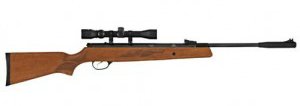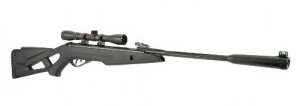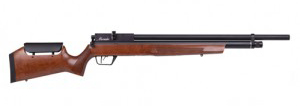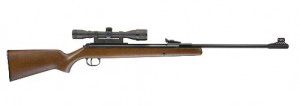-
Weihrauch HW50S Air Rifle Review
The HW50S comes in two calibers: .177 and .22, and both provide one heck of a shot. Weihrauch is a brand known for their high quality, so even before taking my first shot, I knew this air rifle would be balanced and accurate. Beechwood is used on the stock, and […]
-
Weihrauch HW30S Air Rifle Review
Who knew a .177 could be this good? I’m a big fan of the Weihrauch brand, so naturally, I wanted to give the HW30S air rifle a try. A velocity of 675 fps seems a little on the low end, but let me tell you, the precision and balance of […]
-
Stoeger Arms X20S Suppressor Air Rifle Review
The Stoeger Arms X20S is all black in color and surely is a mean looking air rifle that packs a punch. Coming in both a .177 and .22 caliber, there are slight differences seen between both versions, but don’t worry, I will be discussing them both. . Comes with a 4×32 Illuminated […]
-
Ruger Yukon Air Rifle Review
The Yukon is a gas piston air rifle that comes in two calibers: .177 and .22. I went with the .22, which is a bit pricier, but I needed a rifle for pest control. The .177 wasn’t going to cut it for me, but that doesn’t mean it wouldn’t be […]
-
Browning Leverage Air Rifle Review
The Browning Leverage air rifle doesn’t get as much attention as it deserves. It’s powerful, accurate and beautifully designed, but yet not many people seem to be talking about it. After reviewing the Leverage, I was impressed. The Leverage comes in both .177 and .22 calibers. But this isn’t your […]
-
Beeman RS1 Dual-Caliber Air Rifle Review
Ever brought your .177 with you and wished you had your .22? The Beeman RS1 is a dual-caliber air rifle that gives you the best of both worlds. With one simple twist of a bolt, you can switch between a .177 and a .22 barrel. This spring-piston break-barrel rifle isn’t […]
-
Weihrauch HW80 Air Rifle Review
Weihrauch air rifles are the top of the line, and getting my hands on the HW80 has been a long time waiting. Powerful and accurate is how the Weihrauch brands this rifle, and they’re dead right. Featuring 0.177 and .22 caliber options, you’ll shoot at a 1000 or 765 fps […]
-
Crosman Nitro Venom Break Barrel Air Rifle Review
The Crosman Nitro Venom is one of those air rifles you can’t help but fall in love with. It’s deadly accurate, has an excellent range and gives you more than enough power to take down pests or small game. I’ve shot high-end .22s, but I always find myself coming back […]
-
5 Reasons Why I Prefer a .22 Caliber Over .177 Caliber
One of biggest hurdles new hunters face is whether or not to use a .177 or a .22 caliber. The answer for most people will always be the .22 caliber. The .22 caliber is among the most popular in the world for a reason – it’s superior. The following are […]
-
Common Terminology Used In Air Rifle Talk
When you’re reading about air rifles, sometimes you’ll be asking yourself “what the heck are they saying?” The jargon and terminology you come across will probably be new to you, so it’s important to understand some common terms, such as: FPS: This is the feet per second that the pellet […]
Best Air Rifle List For 2020
Under $200
Hatsan 95
Air Rifle


- .177 / .22 / .25 Caliber
- 650 - 1,000 fps
- Spring-piston
- Free Shipping
Most Popular
Gamo Silent Cat
Air Rifle


- .177 Caliber
- Up to 1,200 fps
- Spring-piston
- Free Shipping
Great For Hunting
Benjamin Marauder
Air Rifle


- .177 / .22 / .25 Caliber
- 900 - 1,100 fps
- PCP (Precharged Pneumatic)
- Free Shipping
Top German Made
RWS Model 34
Air Rifle


- .177 / .22 Caliber
- 740 - 1,000 fps
- Spring-piston
- Free Shipping
A Guide to Choosing the Right Air Rifle
The best air rifle is affordable, meets your needs and fits within your skill level. While all levels can shoot a .177 caliber rifle, you wouldn’t expect a child to shoot a .357+ caliber. These models are too powerful and will have a higher recoil, which could potentially hurt the shooter.
Before reading any air rifle reviews, you need to know what you’re up against. After all, you want to make a smart investment.
Type of Air Rifle
There are four main air rifle types. These types dictate how the pellet is propelled out of the barrel. Mostly, you’ll find break-barrel models on the market, but there are other options available as well.
- Spring-Piston / Break Barrel: The most common type. There’s no pumping or cartridges to worry about. Using an underlever, top-lever or side-lever, you’ll cock the rifle and be ready to take a shot.
- Pneumatic / PCP: These are pump rifles. You force air into the rifle and prime it before a shot. You’ll find high caliber rifles often only come in PCP.
- Gas Ram: Much like the spring-piston option, a gas ram is cocked using a lever. These gas ram cylinders last for years and are very easy to shoot.
- CO2: These rifles use a CO2 cartridge, which can run out and require a cartridge switch. If you’re hunting, this may not be ideal. Temperature can also change the power of a shot, which isn’t ideal.
I don’t prefer CO2 models simply because cartridges can go dead and need to be replaced. PCP is good for bigger caliber rifles, but pumping is not ideal when hunting smaller game. Gas Ram and Spring-Piston / break-barrel are both great options. The springs can break and may need to be replaced, but this is not common.
Caliber Options and Shooting Needs
The caliber you choose will directly correlate to your shooting needs. There are a few facts to consider first:
- Larger calibers are best for bigger game hunting.
- Small calibers will travel faster than large calibers.
- Large caliber pellets are more expensive.
For most people, you’ll want to choose a .177 or .22 caliber rifle. These are smaller and ideal for target shooting and killing pests or small game. Ideally, if your goal is to do some light hunting, choose a .22 caliber. The .177 is so small, it often goes through the animal, but doesn’t kill it.
Larger calibers, .357, .50 and .58, are normally found with PCP type rifles and are meant for killing medium to large game. Small deer or boar would fit into this category. However, these pack much more power, and you’ll have to deal with more recoil. For the beginner or younger shooter, these rifles may be too much to handle.
Honestly, it’s hard to find any .58 caliber options on the market today, so you’ll be lucky to find any of these models available.
Scopes
Air rifle scopes allow you to zero in on a target and add magnification into the mix. You’ll find various scope magnification ranges. You’ll want to keep the following in mind:
- Scopes that offer 1X – 4X are ideal for big game hunting if in a 200-yard range.
- Scopes that offer 3X – 9X are ideal for big game hunting if you’re 200 yards or further away.
- Scopes that offer 6X – 24X magnification are the right choice when tracking small quarry.
The standard for objective lens sizes is 40 – 44 mm, so this isn’t a concern. Turrets or adjustment knobs and parallax adjustments allow for fine-tuning and the utmost in accuracy.
Most shooters don’t like scopes that come on lower end rifles. You may even be able to swap yours out for an aftermarket scope if you like.
FPS
Feet per second, or FPS, refers to how fast your pellet will travel. The only time this is a concern is when hunting, but there’s a bigger issue: higher calibers always have a slower FPS. You can find models that boast as high as 1600 FPS or as low as 700 FPS.
The one issue is that the lightest pellets are used during testing, so you probably won’t get the same FPS as advertised.
Does it all matter? Not really. A .22 that has 800 – 1000 FPS will be a killing machine.
Weight
Weight only becomes an issue with a child or when you’re holding your rifle for an extended period of time. The norm is 7 – 10 pounds, but it can be higher or lower depending on the caliber of the gun.
When a heavy-duty scope is added, your rifle will weigh more.
If you’re just starting, try to find a rifle that weighs between 8 and 10 pounds.
Price Ranges
Prices can vary greatly with air rifles. The best air rifle can cost hundreds of dollars, but you can find some options that are very affordable and best sellers. Let’s take a look at a few price ranges:
- $100 and under: You’ll find mostly .177 caliber options without scopes in this range.
- $100 - $200: You can find great rifles in this price range. From .22 calibers with decent scopes to .177 and even the rare .25 caliber option, you’ll find it all. There are exceptional .177 with great scopes in this range. Check out the best air rifles under $200 here.
- $200+: In this range, you’ll find all calibers with exceptional scopes. You’ll also be delving into the higher calibers, such as .357 where you can expect to pay $500 - $600 for a decent model.
Obviously, stick within your budget and read air rifle reviews before making your purchase. There are a lot of models in the $100 - $200 range that compete with models in the $600 dollar range.
If you’re new to shooting, stick with rifles that are below $300.
Maintenance
Many shooters worry about maintenance and upkeep -- it's crucial that you properly clean and take care of your air rifle, otherwise it may not shoot as well as you'd like. Lubing the trigger and cleaning out the barrel every 500 – 1000 shots is normal… and recommended. Make sure to read the owners manual of whatever air rifle you buy and keep it somewhere safe. It's always helpful to reference it if you ever forget the proper way to clean it. Remember, a well maintained rifle will always shoot better and last longer! If you lost or can't find your owner's manual, usually the brand's website will have a digital copy.
What’s the perfect air rifle for you? Following the advice I laid out, you should have a good understanding of what to look for with your next purchase.










